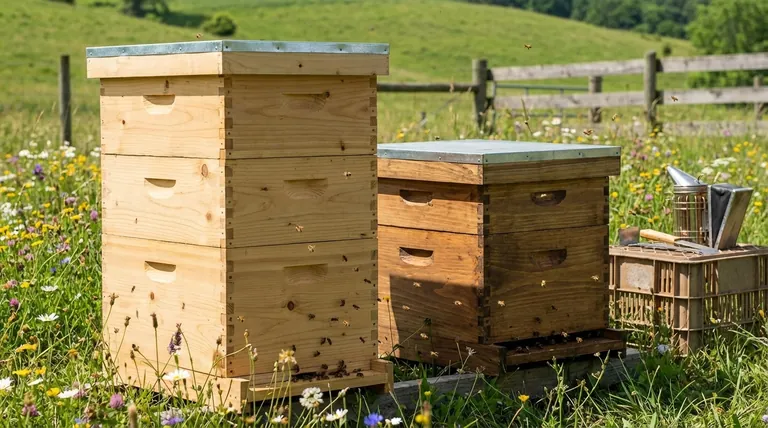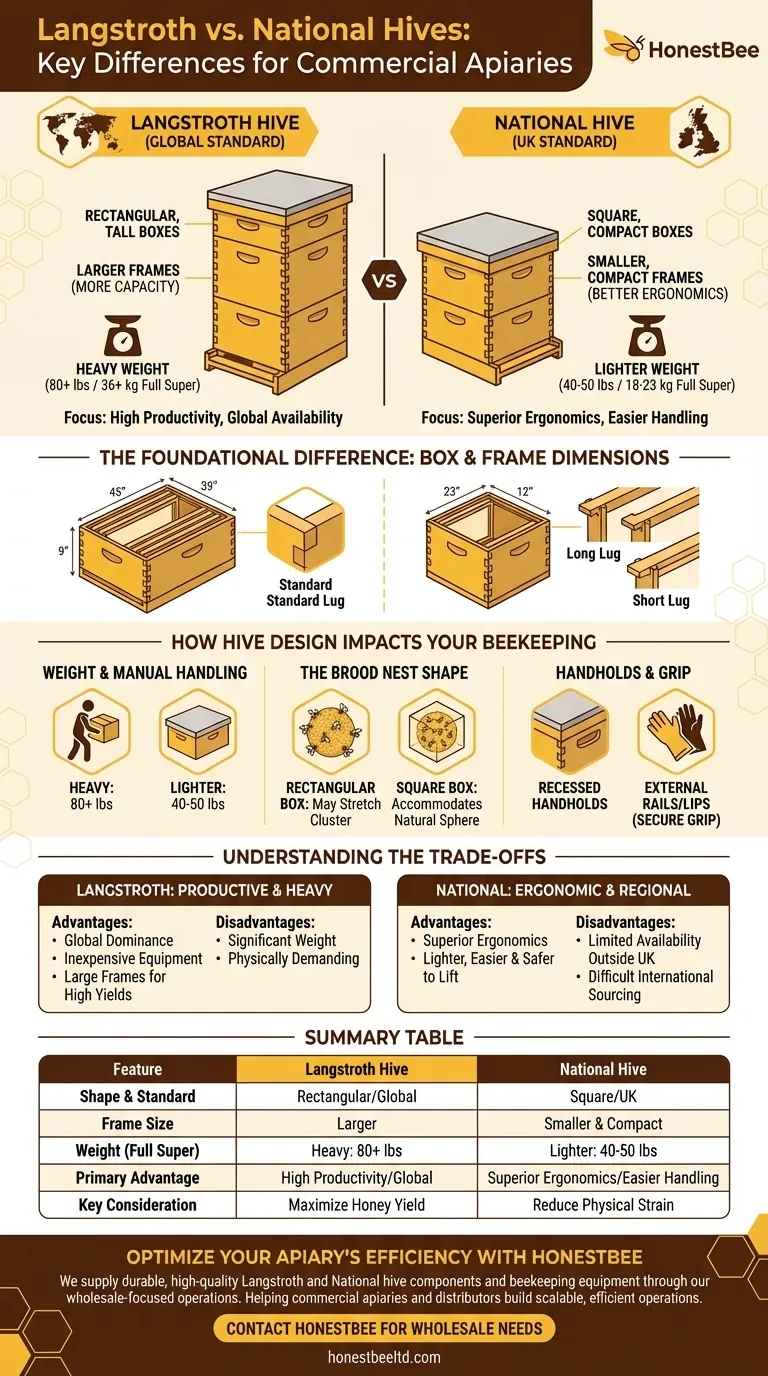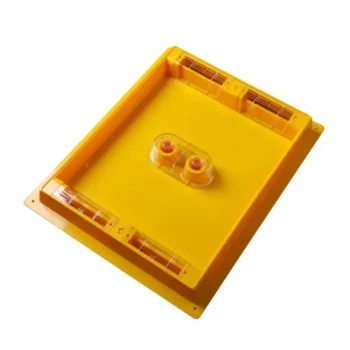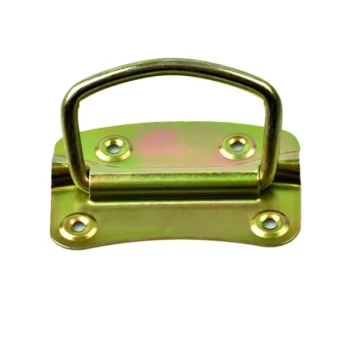At their core, the primary difference between a Langstroth and a National hive is their geometry and frame size. A Langstroth hive, the global standard, is rectangular and uses larger frames. The National hive, standard in the United Kingdom, is square and uses smaller, more compact frames. This single design choice creates a cascade of differences affecting weight, management style, and equipment availability.
Choosing between a Langstroth and National hive is not a question of which is "better," but which is more appropriate for your location, physical strength, and beekeeping philosophy. Your choice directly impacts equipment availability and day-to-day management.

The Foundational Difference: Box and Frame Dimensions
The distinct shape and size of each hive type is the most important factor to understand. Both are vertical, modular hives built on the principle of "bee space," but their components are not interchangeable.
The Langstroth Standard: Rectangular and Tall
The Langstroth hive is the most popular design in the world, particularly in North America. Its boxes are rectangular, meaning they are longer than they are wide.
This larger footprint accommodates larger frames, which can hold more brood and honey per frame. However, this also means each fully-laden box (or "super") is significantly heavier.
The National Standard: Square and Compact
The National hive is the standard in the UK. Its primary defining feature is its square footprint. This means the boxes are shorter and wider than a Langstroth.
The smaller, square boxes result in frames that are smaller and lighter. This makes individual boxes much easier to lift and manipulate, a major ergonomic advantage.
Frame Lugs: A Critical Detail
A key detail in the National hive is the top bar of the frame, which comes in "long lug" and "short lug" versions. The lugs are the ends of the top bar that rest on the hive body.
Long lugs provide a larger, more forgiving handhold for inspections. Short lugs are flush with the hive body, creating a tidier profile but requiring more dexterity to handle. Langstroth frames have a single, standardized lug design.
How Hive Design Impacts Your Beekeeping
The seemingly simple difference in box shape has profound consequences for the day-to-day work of a beekeeper.
Weight and Manual Handling
This is often the deciding factor. A full Langstroth deep brood box or honey super can weigh over 80 lbs (36 kg).
A full National super is significantly lighter, typically weighing around 40-50 lbs (18-23 kg). This makes the National far more manageable for beekeepers who want to avoid heavy lifting.
The Brood Nest Shape
Bees naturally form their winter cluster in a sphere. The National hive's square box is considered by many to better accommodate this natural spherical shape.
The Langstroth's rectangular design can sometimes force the cluster to stretch across two boxes during winter, which may create challenges for the colony in maintaining heat.
Handholds and Grip
Langstroth hives typically feature recessed handholds cut into the front and back walls of the box.
National hives, by contrast, almost always have external rails or lips running along the sides. These are generally considered easier to grip securely, especially when wearing thick beekeeping gloves.
Understanding the Trade-offs
Neither hive is perfect; each represents a set of compromises. Your goal is to choose the set of trade-offs that best aligns with your needs.
The Langstroth: Productive but Heavy
The advantage of the Langstroth is its global dominance. Equipment is inexpensive and universally available, especially outside of the UK. Its larger frames can support highly prolific queens and lead to large honey crops.
The disadvantage is the weight. Lifting heavy boxes is the most physically demanding part of beekeeping, and the Langstroth is the heavyweight champion.
The National: Ergonomic but Regional
The advantage of the National is its ergonomics. The lighter, square boxes with external handholds are simply easier and safer to lift, reducing physical strain.
The disadvantage is its limited availability. Outside of the United Kingdom, finding National hive parts can be difficult and expensive. This lack of a widespread supply chain is its single biggest drawback for international beekeepers.
Making the Right Choice for Your Apiary
The decision between these two excellent hive designs comes down to your personal context and goals.
- If your primary focus is global compatibility and you are based in North America: The Langstroth is the undisputed industry standard with unmatched equipment availability.
- If your primary focus is ease of handling and you are in the UK: The National hive's lighter, square boxes are ergonomically superior and the local standard.
- If you are a beekeeper with concerns about back strain or lifting capacity: The National hive is the clear winner due to its significantly lighter components.
- If your goal is to maximize honey production with the fewest boxes: The Langstroth's larger frame size gives it a slight edge in capacity per box.
Ultimately, the best hive is the one that you can manage effectively and that is well-supported by your local beekeeping community.
Summary Table:
| Feature | Langstroth Hive | National Hive |
|---|---|---|
| Shape & Standard | Rectangular; Global Standard | Square; UK Standard |
| Frame Size | Larger | Smaller, more compact |
| Weight (Full Super) | Heavy (80+ lbs / 36+ kg) | Lighter (40-50 lbs / 18-23 kg) |
| Primary Advantage | High productivity; Global availability | Superior ergonomics; Easier handling |
| Key Consideration | Ideal for maximizing honey yield | Ideal for reducing physical strain |
Optimize Your Apiary's Efficiency with the Right Equipment
Choosing the correct hive type is crucial for the productivity and well-being of your commercial operation. At HONESTBEE, we supply durable, high-quality Langstroth and National hive components and beekeeping equipment through our wholesale-focused operations.
We help commercial apiaries and beekeeping equipment distributors build scalable, efficient operations with reliable gear. Let us equip your business for success.
Contact HONESTBEE today to discuss your wholesale needs and get a quote.
Visual Guide

Related Products
- Telescopic Beehive Outer Cover Lid Roof with Galvanised Sheeting for Langstroth Hive and Beehive Outer Cover
- Professional Hive Top Bee Feeder for Beekeeping
- HONESTBEE Professional Long Handled Hive Tool with Precision Cutting Blade
- Professional Engraved Round Hive Number Tags for Beekeeping
- Professional Galvanized Hive Strap with Secure Locking Buckle for Beekeeping
People Also Ask
- What is the purpose of a garden hive lid in beekeeping? Essential Protection for Your Colony's Health
- What maintenance is recommended for the Langstroth hive roof? Protect Your Hive with Natural Tung Oil
- What is a telescoping outer cover and what are its advantages? Maximize Hive Protection in Harsh Climates
- Can bees enter from both sides of the outer cover? Master Seasonal Hive Management
- What are the two primary lid styles for Langstroth style beehives? Choose the Right Protection for Your Hives



















